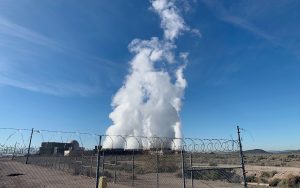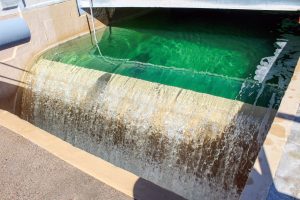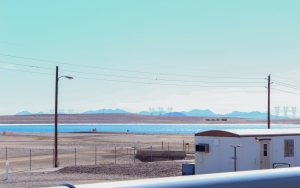- Slug: BC-CNS Palo Verde Water, 675 words.
- 4 photos and captions below.
- Video here.
By Madison Staten
Cronkite News
PHOENIX – There’s something in the Buckeye groundwater – a high mineral and salt content – that makes it hard to use, but the Palo Verde Nuclear Generating Station wants to tap into that source to reduce the amount of more valuable wastewater it now uses to cool the plant’s three reactors.
The plant uses millions of gallons of treated wastewater, much of which comes from Phoenix’s 91st Avenue Wastewater Treatment Plant. Heat from nuclear reactions boils water into steam, which turns the turbines that generate electricity. The steam then must be cooled and condensed. Palo Verde is looking for additional water sources to reduce its wastewater use by 20%.
“Water sources that we’ve been looking at are poor-quality groundwater sources that come from the Buckeye waterlogged area,” said Jeffrey Brown, senior consulting engineer for Arizona Public Service, which operates the plant. “We are able to use some of that water instead of effluent (wastewater) because of the tertiary treatment system that we have here at Palo Verde” to remove the salts and minerals.
Water is vital for the generating station because it’s in the desert, about an hour’s drive west of Phoenix. Despite being nowhere near a large body of water, Palo Verde, which is owned in part by Arizona Public Service, is the largest nuclear generating station in the country by net generation. The scale of the production shows in the amount of water used every minute.
“In the winter, we can use up to 40,000 gallons per minute, and that makes up for the evaporation rate of the cooling towers at the nuclear plant. In the summer it’s more, it’s up to 60,000 gallons per minute,” said Rick Lange, the plant manager of Palo Verde Water Resources.
Sandy Bahr, director of the Sierra Club’s Grand Canyon Chapter, believes the real issue isn’t the source of the water but the volume of water the plant uses.
“The utilities say, ‘Wow, OK, we are using the treated wastewater,’ like somehow it’s not a big deal that it’s using so much water,” she said. “Treated wastewater can be used for all kinds of other things, including habitat restoration. So it is water that is not available for other use.”
Now, Palo Verde is looking for additional water sources to cut down on increasing costs for wastewater and to conserve water.
“It’s increasing our power costs,” Brown said. “Our objective was to come up with programs that we could run to replace that effluent with more affordable water sources.”
The idea to use even dirtier water stems from a partnership with Sandia National Labs, a national nuclear research and development laboratory in New Mexico. Researchers at the lab have created models that identify areas of improvement for Palo Verde.
“We created the partnership because of objectives that we had regarding the production and cooling costs for power operation here in Palo Verde,” Brown said. “One of the things that increases disproportionately is the cost of cooling, which is related to the water that we use.”
The facility wants to implement the use of this dirtier water within the year.
“We already have funding and sightings for the wells,” Lange said. “We just need approval from the state, and we’re working with the state and the farmers in the area to work through issues and get that in place. We plan on this year being able to start pumping water and that will test all these systems.”
Palo Verde plans to continue conservation efforts through the development of additional cooling technology and its continued exploration of other water options.
“You’re going to come back five years from now and work you’re going to say, ‘Wow, you’re using a lot less of that sewage water because you’re being more efficient and you’re coming up with worse, worse sources of water that can meet your needs,’” Lange said.
This story is part of Elemental: Covering Sustainability, a multimedia collaboration between Cronkite News, Arizona PBS, KJZZ, KPCC, Rocky Mountain PBS and PBS SoCal.
^_=



